3 September 08: Philly Skyline vs Penny Postcards:
St George's Hall
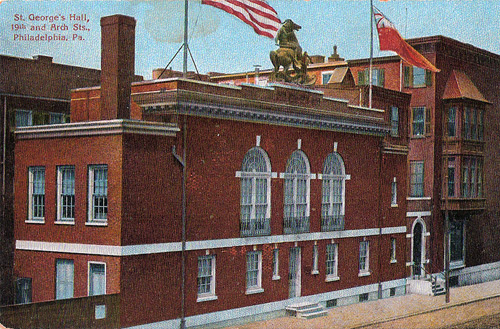 It's a Demolition Party -- and THE WHOLE CITY'S INVITED! Ladies and gentlemen, boys and girls, my fellow interested and engaged citizens of Philadelphia, step right up and buy your ticket right now, for there will be no Will Call when the wrecking ball is through. The Demolition Party goes on -- as we speak! Perhaps you've heard about PECO's demolition of the northern portion of its Delaware Substation (pictured just below), the powerful structure designed by John T Windrim next to Penn Treaty Park in Fishtown. And maybe you've heard the concerns over the destruction of the Garrett-Dunn House, designed by Thomas Ustick Walter in Mount Airy. You may have even caught wind that the classical Bank at Front & Norris, which Nathaniel Popkin touched upon in a story about Norris Square for The Possible City in February, is soon a-comin' down. 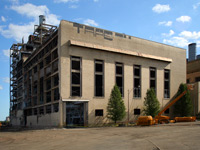 It's been a good year in the demolition community . . . all of the buildings, a dozen or so, that once stood in the way of the expanding Convention Center are now
gone. And Comcast-Spectacor was happy to announce that the Spectrum will be coming down next year for Philly Live, a complex that could be built, oh, on any of the
acres and acres of surface parking already there.
It's been a good year in the demolition community . . . all of the buildings, a dozen or so, that once stood in the way of the expanding Convention Center are now
gone. And Comcast-Spectacor was happy to announce that the Spectrum will be coming down next year for Philly Live, a complex that could be built, oh, on any of the
acres and acres of surface parking already there.But right now? Right now in our citywide Demolition Party? It's St George's Hall who's the belle of the ball! The Penny Postcard above is of what was once known as, well, St George's Hall. Who? St George's Hall. The Society of the Sons of St George dates back to 1772, when it was "founded on the premise of giving advice and assistance to Englishmen in distress." (StGeorge1772.org.) In one regard, it could have been considered sympathizing with the enemy in the colonies. In another, the Society of the Sons of St George could be admired for their staying power, akin perhaps to the Freemasons, as they're still in existence today, effectively as an English heritage club. (St George's Cross is the red cross that emblazons the flag of England, the same cross that is one of the central components of the Union Jack.) The club survived the Revolution, and by the mid-19th century had grown to a point of needing its own social hall. In the 1850s, they purchased a building belonging to the attorney Matthew Newkirk, at 13th & Arch. It was designed by? The aforementioned Thomas Ustick Walter. (Recall if you will a Philly Skyline piece on Walter's US Capitol dome, found HERE (24 September 07: A Philadelphian in the Capitol).) 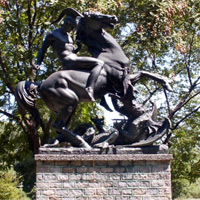 In 1876, the Society commissioned a sculpture from London of St George slaying the dragon (pictured at left, original photo by Chris Purdom at Philart.net), the allegorical tale in which the circa-Roman Empire soldier killed a plague-bearing
dragon on the notion that the people he saved convert to Christianity. (St George is not just the patron saint of England, but also Georgia, from which it takes its
name, and Russia, who features the dragon slaying in its coat of arms, as well as several other countries like Portugal and Brazil, and organizations like the Boy
Scouts of America.) The sculpture was placed atop the pediment topping the portico of St George's Hall. The Free Library has a nice photo of it HERE.
In 1876, the Society commissioned a sculpture from London of St George slaying the dragon (pictured at left, original photo by Chris Purdom at Philart.net), the allegorical tale in which the circa-Roman Empire soldier killed a plague-bearing
dragon on the notion that the people he saved convert to Christianity. (St George is not just the patron saint of England, but also Georgia, from which it takes its
name, and Russia, who features the dragon slaying in its coat of arms, as well as several other countries like Portugal and Brazil, and organizations like the Boy
Scouts of America.) The sculpture was placed atop the pediment topping the portico of St George's Hall. The Free Library has a nice photo of it HERE. In 1903, the Society decided to sell the building and move to the 19th & Arch building, built in the 1850s and pictured in the postcard above. The 13th & Arch portico and its ionic columns, but not the St George and Dragon statue, were moved to Princeton University in 1905 and the building was demolished. The statue was placed atop the center of the club's new home, as seen above. The Society of the Sons of St George called the building along 19th Street between Race and Cuthbert home for twenty years, including World War I, when the society was active in contributing money to war efforts via the Prince of Wales and protesting the teaching of German, the enemy's language. They sold the building, which they'd bought in 1903 for $32,121, for $80,000 in 1923 whe they moved to 19th & Spring Garden. Now? Kaboom. 1900 Arch Street Associates, owned by Philadelphia Management's Ron Caplan, is in the process of demolishing it and the adjacent properties. One of those, the four-story rowhome at 1900 Arch, was owned in the 1870s by Samuel Shipley, a Quaker businessman whose lineage is traced back to the emigration led by William Penn in the 1680s, and whose grandfather was the founder of the American Anti-Slavery Society. As reported by Jeff Shields for the Inquirer, the same building was occupied by Fernley & Fernley, a non-profit organization management company, from 1951 to 2004. According to BRTweb, that is when 1900 Arch Street Associates purchased the properties for $1.7M. Since then, the buildings have stood empty. Exactly what 1900's plans are for the site are unclear; phone calls there and to Philadelphia Management were unreturned. What I've heard is that "there are no immediate plans." And, earlier this year, Caplan's group presented plans to the Logan Square Neighborhood Association for . . . wait for it . . . a surface parking lot. If this were to happen, that would make not one, not two, but three of the four corners of 19th and Arch Streets surface parking lots. In Center City Philadelphia, that is downright embarrassing. Consider then that the surface parking lot directly across the street, on which Walnut Street Capital expects to build the 1,500' American Commerce Center, was bought for $30M. I wonder which seems more desirable in a weak market 2008: building yet another condo tower, or flipping a property with pesky historical buildings already out of the way. In this New Day, in which the Nutter administration has done a great job placing emphasis on planning and design, and promoting green building to the point of having a Sustainability Director, it seems that little has been done in the way of historic preservation. The Boyd Theater scored a victory with the Historical Commission's unanimous designation for the Register last month, and that is largely thanks to the efforts of the Friends of the Boyd. Here again, that was largely thanks to the Friends of the Boyd. Put another way, it took a successful, huge grassroots movement to save it. There are no Friends of the Former St George's Hall. No Friends of the Delaware Substation. No Friends of the Spectrum. (Err, well, there is a Friends of the Spectrum, but it's an autism support group, not a non-profit trying to preserve the site of the Flyers' only Stanley Cups and the city's last championship, the 1983 Sixers.) The Preservation Alliance for Greater Philadelphia publishes an annual list of endangered properties. It's a non-binding list made primarily to raise awareness about unprotected (i.e. undesignated) buildings, such as the Stephen Girard Building at 12th & Ludlow, one of the city's earliest skyscrapers which was part of the Girard Block property on which Trinity Capital recently wanted to build two towers. The Preservation Alliance is taking nominations for its 2008 list now. Unfortunately, it's too late for the former St George's Hall now. You know -- it's just another building. Just another building from another era in a city whose religion is its history. While the likes of Independence Hall and the PSFS Building and City Hall are no false idols, it's the simple congregation -- St George's Hall, the Philadelphia Life Insurance Building and its annex, the 1600 block of Sansom Street -- that suffers when its history isn't deemed important enough to preserve. A good portion of the 19th century's workshop of the world was razed for Independence Mall, our 20th century shrine to the 18th century, after all. Rob Stuart, president of the Logan Square Neighborhood Association, laments the demolition at 19th & Arch, saying "the best we can hope for now is a historical marker." He also notes that 1900 would need a zoning variance to develop a surface parking lot there. It seems unlikely that LSNA will readily endorse one. PECO says that they're only taking down the modern northern portion of the Delaware Substation, that they're leaving the Windrim building intact. Garrett-Dunn still stands, but largely stripped and in poor condition. The fate of the Front & Norris bank is unclear. But St George's Hall is as good as gone -- it's already halfway there. 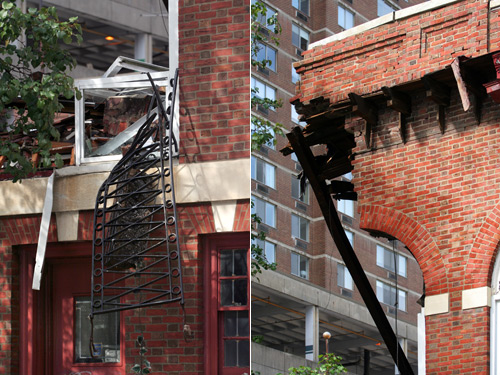 It's unbelievable to think that this city, in spite of everything it's learned in recent years, in spite of a New Day, still allows the demolition of historical buildings with "no immediate plans" or worse, another fucking surface parking lot. * * * For a Philly Skyline vs Penny Postcard before-and-after comparison, please click the image below. (Note the bay window on the building on the right, which was reduced from four stories to two stories in the mid-1900s.) 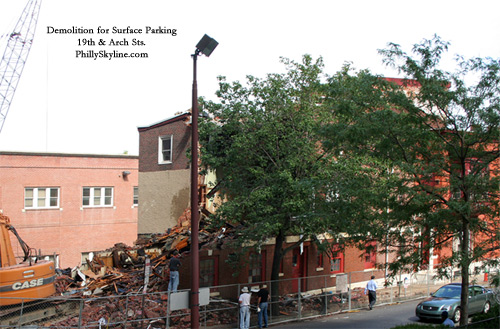 . . * * * If there's any good news to take from this, it's that the bronze and masonry statue of St George Slaying the Dragon lives on. The statue, whose sculptor is unknown, was cast in 1876, in time for the Centennial. After speaking with Margot Berg, the director of the City's Public Art Program, we determined this as the journey for the sculpture: it was commissioned in 1876 and after the Centennial placed on the portico at St George's Hall at 13th & Arch. In 1903, when the Society moved to 19th & Arch, so too did the sculpture. In 1923, it moved again with the Society to 19th & Spring Garden. In 1935, for some reason, it was moved into storage at the Philadelphia Museum of Art, where it stayed for 40 years. In 1975, they dusted it off and dedicated it on West River Drive, in time for the Bicentennial. That's where it remains today -- Martin Luther King Drive, near Black Road. –B Love * * * NOTES & SOURCES: • Old Philadelphia in Early Photographs, 1839-1914, Robert Looney, 1976 • History of the Society of the Sons of St George, Theodore Knauff, 1923 • "St George's Hall" postcard published by Hugh C Leighton Company, Portland ME, appr. 1908 • Contemporary photo taken by B Love, 3 September 2008 • Original postcard not written on or mailed • The stain on the postcard was there when I bought it, I swear 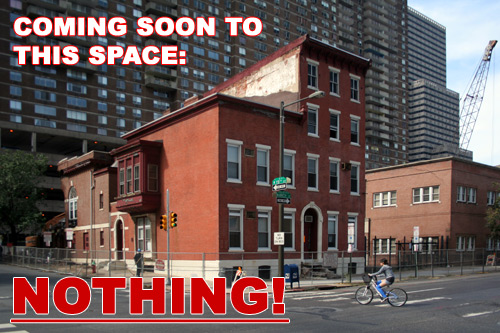
PREVIOUSLY ON PHILLY SKYLINE VS PENNY POSTCARDS: 6 May 08: FDR Park Gazebo 17 April 08: Walnut Lane Bridge 18 March 08: The Parkway & the Skyline 10 March 08: 1800 Arch Street 27 February 08: New Market 7 March 07: Letitia Street House |
